


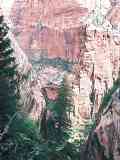








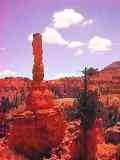




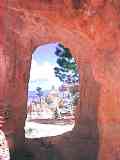
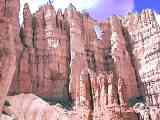


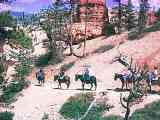
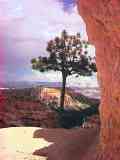
Subject: Panasonic KXL-600A (CoolShot) --- color correction data
Last week I bought my wife a digital camera for a trip to Zion National Park and Bryce Canyon. She wanted something very lightweight, so I got her a Panasonic KXL-600A, the "CoolShot". Weight 6 oz. (incl. batteries), volume 9.2 cu.in. (5% bigger than the PalmPilot and similar form-factor: 5x2.3x.8" vs 4.7x3.1x.6"). T-Zone price: $400, plus $290 for a SanDisk 15MB compactflash memory (192 photos at the finest resolution, so 80KB per picture, even less than the Casio QV-10 so one shouldn't hope for too much).
Pictures taken from 4 feet (with focus set on portrait) were sharper than from my fixed-focus Minolta Dimage (bought from Keeble and Shuchat the same day), which uses 80-120KB per picture depending on amount of detail. (I'm not convinced the Dimage's fixed focus is the limiting factor here, since 4 feet for a digital camera is like 30 feet for a regular camera.)
On the other hand the Dimage's advantages over the CoolShot are much better color, 2.5x zoom, flash (albeit weak, only useful for ~4 feet), detachable lens. The CoolShot has neither flash nor zoom, but does have three manual focus settings (macro, portrait, infinity) as well as a manual filter for bright or dim light, another advantage over the Dimage which does not perform well in dim light at more than about five feet (a slave flash might extend the range to 20 or more feet---there is no obvious way to trigger a slave flash on the CoolShot).
The CoolShot has a Brownie-style viewfinder, but it also has an NTSC PCM output jack. (The Dimage has a built-in LCD on the back.) Hence for more informative feedback and instant review of recent shots, one can plug in any regular monitor such as a Sony Walkman, or a 35" TV for those with strong arms, or more conveniently a $200 1.5" (diagonal) Panasonic monitor designed to attach neatly to the CoolShot, adding ~50% to its volume. The camera+monitor combination is ordered as the KXL-601A.
The compactflash memory makes it possible to transfer the whole 15MB to your laptop or PC in 10 seconds, namely the time to eject it from the camera and insert it in your laptop. Transferring that much data via the serial line takes half an hour even at the maximum speed of 115 Kbaud, which given the 10 second alternative is simply out of the question.
The images are standard JPEG's that your browser or any JPEG viewer can read, except in one regard: the color is way off. The main point of this message is to give some data that will allow users of John Bradley's very versatile xv program to color-correct the CoolShot's images.
The following values for xv's color editor, formatted for an X-windows .Xresources file, do the job.
xv*preset1*satval: -6 xv*preset1*igraf: S 4 : 0,0 : 49,105 : 126,207 : 255,255 xv*preset1*rgraf: S 4 : 0,0 : 86,52 : 146,164 : 255,255 xv*preset1*ggraf: S 4 : 0,0 : 92,58 : 189,162 : 255,255 xv*preset1*bgraf: S 4 : 0,0 : 78,48 : 186,159 : 255,255
These are the saturation, intensity, and rgb coordinates for the color correction curves as output by xv's Cut Res command.
Unfortunately I don't know how to translate these to any other JPEG viewer's color correction system, so I'll have to leave this to someone who knows both xv and some other system.
At some point I should open up the software that came with the camera, presumably it does this correction. However when the JPEG images are sitting right there on a PCMCIA card, it is *so* much easier to simply plug them in and browse them right away instead of hassling with installing, learning, and messing with yet another damned software package, whether or not badly done (more likely than not---I love computers but I hate software, which is what 35 years of writing it does to you).
None of the above should be construed as an endorsement of either the CoolShot or the Dimage, both of which have significant weaknesses. Nevertheless both have their unique points, in particular the CoolShot's tiny size and the Dimage's detachable zoom lens. And both can be downloaded in a jiffy via a PCMCIA port, which as far as I'm concerned is an absolute must for any digital camera.
Vaughan Pratt